[Note: This narrative was originally written as a homework assignment for a course in professional genealogy in 2014.]
Two single German immigrants, living only 10 miles apart in the old country, came separately to Cincinnati in 1847. Marrying, they went on to experience hardships and success over the latter half of the 19th century. This is their story.
SEBASTIAN KASSHEIMER, son of Mathaus and Magdalena (Huber) Kässheimer, was born on January 18, 1825 in Wyhl, Emmendingen, Baden-Württemberg, Germany, and died on January 19, 1895 in Cincinnati, Hamilton County, Ohio, USA at age 70.[1] Sebastian married LORETTA STRILEY, daughter of Daniel and Walburga (Bürkle) Streüle, on April 9, 1850 at St. Philomena Catholic church in Cincinnati.[2] Loretta was born on August 4, 1830 in Merdingen, Breisgau-Hochschwarzwald, Baden-Württemberg, Germany, and died on January 10, 1909 in Cincinnati at age 78.[3]
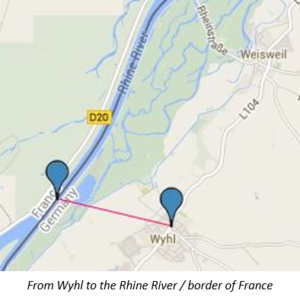
Sebastian’s birthplace of Wyhl was a small town in southwest Germany, in the state of Baden (now Baden-Württemberg). Wyhl lies on the western border of Germany, about half a mile east of the Rhine River, which separates Germany from France.[4]
Loretta’s birthplace of Merdingen was also in southwest Germany and, like Sebastian’s birthplace, was also in the state of Baden.[5] Merdingen was approximately ten miles from Wyhl, so Loretta and Sebastian grew up near each other, but may not have known each other then.[6]
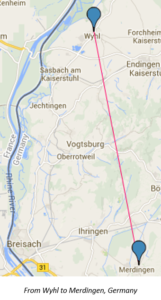
Both Sebastian and Loretta would have spoken high German, as opposed to low German, due to their origins in southern Germany.[7]
Emigration
Sebastian left Wyhl for America in 1847, when he was twenty-two years old.[8] While his reason for leaving is unknown, many Germans left due to famine, lack of opportunities, or to follow other relatives.[9] Sebastian traveled to a port in Le Havre, France, presumably by boat up the Rhine river to the North Sea, and then westward to Le Havre. He booked passage on the Ship Burgundy, which arrived in New York, New York on February 24, 1847.[10]![]() His trip lasted about 6 weeks.[11] By 1850, he had made his way to Cincinnati. It is not certain by which route he traveled, as there were many routes via rivers and canals and, of course, over land.[12]
His trip lasted about 6 weeks.[11] By 1850, he had made his way to Cincinnati. It is not certain by which route he traveled, as there were many routes via rivers and canals and, of course, over land.[12]
Loretta also left Germany in 1847. She was seventeen, and she did not travel alone. Loretta traveled with her father and mother, and what appeared to be her siblings.[13]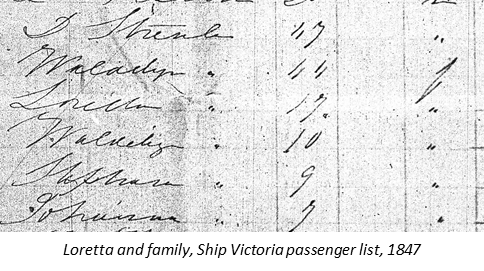
Settling in
Sebastian and Loretta married on April 9, 1850 in St. Philomena Catholic church in Cincinnati.[14] Just the month before, Sebastian had declared his intention to become a U.S. citizen.[15] He may have even become a citizen, but his naturalization record has not been found and likely does not exist due to a courthouse fire.[16]
The couple chose to make their home near a river, as a lot of Germans did.[17] In 1850, they lived in Fulton Township, which was the home of the steamboat industry in Cincinnati.[18] The township was located a few miles east of downtown Cincinnati, and between the Ohio River to the south and the hillsides of Walnut Hills to the north.[19] Fulton was a major access route between downtown Cincinnati and suburbs to the east.[20]
For their entire married life, Sebastian and Loretta’s homes were in the same area, although the street names and house numbers changed over time: on Front Street, at Little Miami Railroad near Torrence Road, Tecumseh which became Lodwick which became Hoff Ave.[21]
Both Sebastian and Loretta could read and write, according to the U.S. federal censuses.[22] These abilities helped prepare them for the years of work ahead.
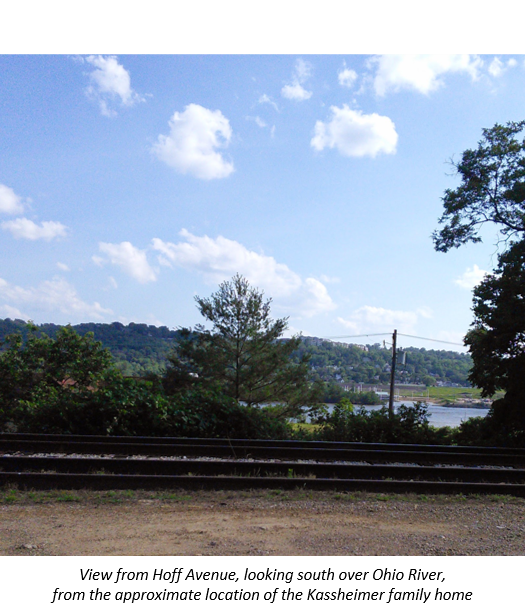
The life of a market gardener
Sebastian was a gardener – a market gardener, to be exact.[23] Market gardening was difficult and Sebastian would have endured long days.[24] His success would have depended on the weather.[25] Usually, market gardeners in the second half of the 1800s grew vegetables and fruit.[26] Of the local markets in Cincinnati, Sebastian likely sold at the Pearl Street market since that was closest to his farm.[27] He probably made three trips per week into town to sell his produce.[28]

Location was often a huge factor in the success of anyone’s efforts. Sebastian and Loretta had chosen to live and farm just outside of Cincinnati, likely because the land was cheaper.[29] Their farm was located near multiple transportation modes: the Ohio River, the Little Miami Railroad and the Miami-Erie Canal.[30] Sebastian had great opportunity for distribution of his market produce and he likely distributed to other cities.[31] Expenses (cost of land) were low and opportunity for income was high. Risk was even mitigated by choosing to live up hill from the river, away from all but the most severe floods.[32]

As seen in the table below, a flood reached its highest point since 1832 in 1884. The flood reached a peak of 71 feet.
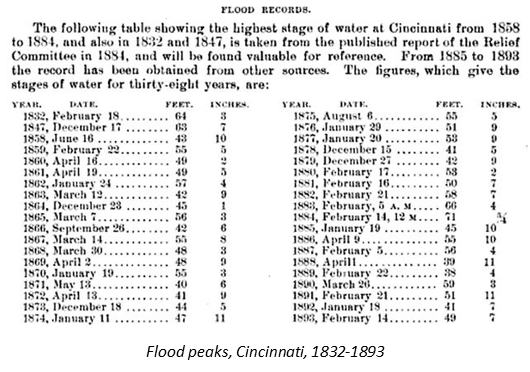
The Kassheimer home narrowly escaped this severe flood, as seen in this map of the 1884 flood. The blue colored area represents the flood, while the red “X” indicates the location of the Kassheimer home.[33]
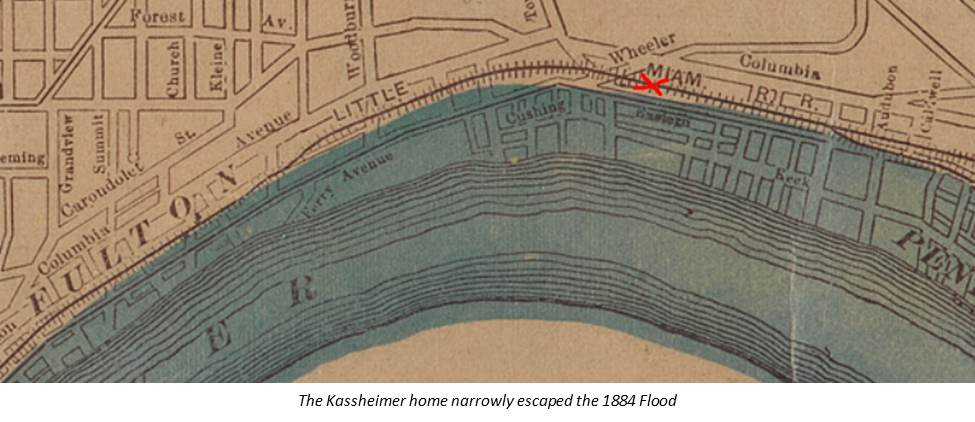
Sebastian seems to have been a wise business man. He also seemed successful, judging by his income on the federal agricultural censuses.[34] In 1850, his market produce was worth $160. By 1870, it was worth $1000.[35] Also, Sebastian loaned $901 to a man in 1858. He must have had some cash reserves to do that.[36]
Sebastian initially grew Irish Potatoes to sell at market.[37] By 1870, he had switched to selling wine, which means he must have had a vineyard. Many citizens devoted themselves to cultivating vineyards, with more than 300 vineyards within 20 miles of Cincinnati.[38]
Civil War
Sebastian was of the right age to serve in the Civil War, and he did not meet the criteria for exemption from service.[39] However, no record of Sebastian serving in the Civil War has been located.[40] Perhaps he paid a substitute to serve on his behalf.[41]
Co-founder of St. Rose church
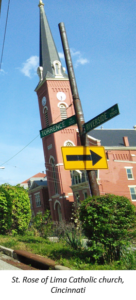
Sebastian was one of the founders of St. Rose of Lima Catholic church in 1867. He served as Vice President on the committee that formed the church.[42] Sermons were in German and so were the school lessons.[43] This photograph of St. Rose shows that it is located on Riverside Drive, across from Torrence Road.[44] It is likely that Sebastian and Loretta’s children attended St. Rose school since the family belonged to the parish and lived across the street from it. Sebastian and Loretta had 11 children in total.[45]
Exciting times
From 1856-1867, the Roebling Suspension Bridge, was built. It spanned the Ohio River, connecting Ohio and Kentucky. The bridge was a prototype to the famous Brooklyn Bridge in New York and was built by the same man, John A. Roebling.[46] Sebastian and his family probably saw the Roebling bridge being built and, once completed, walked or drove across it.
Other interesting events the Kassheimer’s probably witnessed include a visit from Abraham Lincoln in 1859, during his presidential campaign.[47] Then there was the Civil War, from 1861 to 1865, when lots of soldiers were stationed at Camp Dennison, and there was Morgan’s Raid in 1863.[48] In 1869, the Cincinnati Red Stockings became the “first regular professional baseball team” in the country.[49] The Kassheimer family may have even attended this game.
Sad times
In 1877, one of Sebastian and Loretta’s children, Julia, died from coal-fire burns.[50] Two years later, another child, William, died at only age two.[51] Three other children died, sometime between 1850 and 1880, and they each died likely before the age of 10.[52] Surely, the Kassheimer family grieved the loss of these five children.
Farewell
Sebastian died on January 19, 1895 at the family home. He was buried in Calvary Cemetery, in Evanston (a Cincinnati neighborhood).[53] Sebastian’s will left everything to Loretta, after providing for any existing debts and funeral expenses, of course.[54] When Loretta applied to have Sebastian’s will administered, she listed all six of their remaining children as heirs. Also, Loretta’s signature was captured on the document.[55] Loretta lived another fourteen years after Sebastian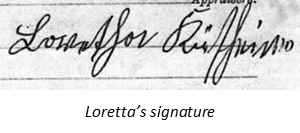 passed away. She died on January 10, 1909 and was buried with Sebastian and their deceased children in Calvary Cemetery.[56] The Kassheimer family’s cemetery plot has multiple names and dates on the same monument.[57] The large gravestone speaks to Sebastian’s success at market gardening. But more importantly, the family is together.
passed away. She died on January 10, 1909 and was buried with Sebastian and their deceased children in Calvary Cemetery.[56] The Kassheimer family’s cemetery plot has multiple names and dates on the same monument.[57] The large gravestone speaks to Sebastian’s success at market gardening. But more importantly, the family is together.
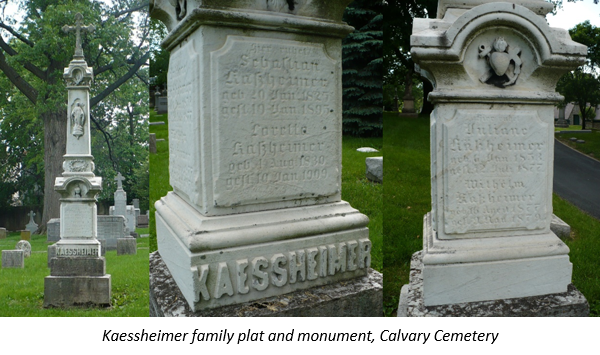
Farm converted
In the final account of Sebastian’s estate in 1912, there is a disbursement listed for surveying subdivision lots.[58] The Kassheimer farm was converted into a subdivision, divided up into small lots. Today, an online map still shows the subdivision listed on the Recorder’s office maps as “Kassheimer Commr Sub.”[59]
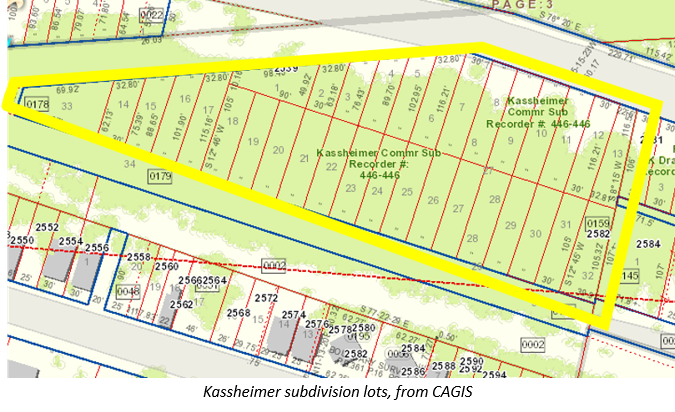
Summary
In 1847, Sebastian and Loretta came to America from small, rural towns in Germany. They came separately to a big city, the city of Cincinnati, married and lived the rest of their lives there. Sebastian had a successful career in market gardening. Loretta raised their children and took care of the home. And the Kassheimer surname lives on, not only in their descendants, but also in the name of a subdivision.
List of children
2 i. [unknown] Kassheimer died before June 9, 1900.[60]
3 ii. [unknown] Kassheimer died before June 9, 1900.[61]
4 iii. [unknown] Kassheimer died before June 9, 1900.[62]
5 iv. Julia Kassheimer was born on Jan 6, 1853, presumably in Cincinnati, died on July 12, 1877 presumably in Cincinnati, and was buried on July 14, 1877 in Cincinnati.[63]
6 v. Adelaide Mary Kassheimer was born on September 14, 1857 in Cincinnati, died on May 17, 1927 in Cincinnati, and was buried on May 21, 1927 in Cincinnati.[64]
7 vi. Frank Kassheimer was born on December 18, 1859 in Cincinnati, died on August 24, 1926 in Cincinnati, and was buried on August 27, 1926 in Cincinnati.[65]
8 vii. Rosa Kassheimer was born on July 3, 1865 in Cincinnati, died on January 14, 1946 in Cincinnati, and was buried on January 17, 1946 in Cincinnati.[66]
9 viii. Joseph Kassheimer was born in March 1869 in Cincinnati, died on August 14, 1902 in Cincinnati, and was buried on August 18, 1902 in Cincinnati.[67]
10 ix. Mary Kassheimer was born in September 1870 in Ohio and died on May 23, 1946 in Pittsburgh, Allegheny County, Pennsylvania, USA.[68]
11 x. Josephine Kassheimer was born on January 29, 1876 in Cincinnati, died on February 17, 1940 in Cincinnati, and was buried on February 20, 1940 in Cincinnati.[69]
12 xi. William Kassheimer was born on April 16, 1877 in Cincinnati, died November 9, 1879 in Cincinnati, and was buried on November 10, 1879 in Cincinnati.[70]
[1] Katholische Kirche Wyhl (Wyhl, A. Emmendingen, Baden, Germany), “Kirchenbuch, 1649-1900,” p. 153, Sebastian Käsheimer, 18 January 1825; FHL microfilm 907,197, item 2. Geboren 18 Jan [1825], Sebastian Käsheimer, vater [father] Mathaüs Käsheimer schuster [shoemaker], mutter [mother] Magdalena Huber. Cincinnati, Ohio, “Deaths, Volume 17” (1895), p.8, no. 357, Sebastian Kassheimer. d. 19 January 1895. “Sebastian Kaesheimer,” The Cincinnati (Ohio) Enquirer, 20 January 1895, p.5. “Saturday morning, at 6:45, at his residence, L. M. Rail-road, east of Torrence road. Burial from residence, Tuesday morning, at 9 o’clock. Services at St. Paul’s Church.” “Sebastian Käsheimer,” Cincinnati (Ohio) Volksfreund, 20 January 1895, p.8; certified translation by Kenny Burck: “died 19 Januar 1895, 70 years old, born in Kensingen, Baden, left behind Loretta Käsheimer, born Streihle, wife.”
[2] Probate Court of Hamilton County, Ohio; Marriage Volume A24: 190, No. 833. Sebastian Kuschemier to Lorette Streile, 1850. 9 April 1850 at St. Philomena Church. [Lorette is listed as “Dorothea Streile” in the marriage return section.] St. Philomena Church (Cincinnati, Hamilton County, Ohio), marriage of Sebastianum Kascheimer and Dorotheam Streile (1850); photocopy of a page from an unidentified register, supplied by an unknown archivist at the Historical Archives of the Chancery, Archdiocese of Cincinnati, Cincinnati, Ohio, 2012.
[3] Katholische Kirche Merdingen (Merdingen, A. Breisach, Baden, Germany), “Kirchenbuch, 1641-1909,” p.155, no. 40, Loretta Streüle, 4 August 1830; FHL microfilm 870,246, item 1. Certified transcription by Kenny R. Burck: “1830 the 4th August, Loretta Streule, tochter [daughter] Daniel Streule [and] Waldburga Bürkle.” Ohio Department of Health, death certificate no. 09-2242 (1909), Loretta Kassheimer; Bureau of Vital Statistics, Columbus. “Loretta Kaffheimer,” The (Cincinnati, Ohio) Post, 11 January 1909, p. 7.
[4] Free Map Tools, “Measure Distance Map” (http://www.freemaptools.com/measure-distance.htm : accessed 19 June 2014). Distance between Wyhl and Rhein River/border of France is 1.564, based on a search for “Wyhl, Germany, and subsequent manual clicks on the map. Wikipedia, (http://www.wikipedia.org), “Wyhl,” rev. 00:15, 19 June 2014. “Wyhl is a municipality in the district of Emmendingen in Baden-Württemberg in southwestern Germany.”
[5] Wikipedia, (http://www.wikipedia.org), “Merdingen,” rev. 00:25, 19 June 2014. “Merdingen is a town in the district of Breisgau-Hochschwarzwald in Baden-Württemberg in Germany.”
[6] Free Map Tools, “Measure Distance Map.” Merdingen is approximately 10 miles from Wyhl.
[7] Ernest Thode, Atlas for Germanic Genealogy, (Marietta, OH: author, 1983), [chapter and page unknown]. Residents of Baden spoke high German.
[8] Passenger Lists of Vessels Arriving at New York, 1820-1897, microfilm publication M237 (Washington: NARA, [year unknown]), roll 65; Ship Burgundy, 25 February 1847, for Sebast. Kesscheimer, p. 3, line 28. Kesscheimer Sebast., 22, M, occupation: [Farmer], country to which they severally belong: [Badois], country in which they intend to become inhabitants: [United States].
[9] FamilySearch Wiki, (http://familysearch.org/learn/wiki/en/), “Germany Emigration and Immigration,” rev. 00:09, 26 June 2014.
[10] Hamilton County, Ohio, Declarations of Intention Volume 2: 220, Sebastian Kessheimer, 1850; University of Cincinnati’s Archives and Rare Books Library, Cincinnati. Sebastian left Havre on 8 January 1847 and arrived in New York on 24 February 1847. Passenger Lists of Vessels Arriving at New York, 1820-1897, microfilm publication M237 (Washington: NARA, [year unknown]), roll 65; Ship Burgundy, 25 February 1847, for Sebast. Kesscheimer, p. 3, line 28. The master of the ship swore to his manifest in the port of New York on 25 February 1847.
[11] Ibid.
[12] FamilySearch Wiki, (http://familysearch.org/learn/wiki/en/), “US Migration Canals,” rev. 20:29, 22 June 2014. George Herancourt, “Diary of George Herancourt,” p. [unknown]; MssVF 3555, Cincinnati History Library and Archives, Cincinnati, Ohio. George, a German immigrant in 1830, traveled from Havre, Germany to New York, and then to Philadelphia in order to get to Cincinnati.
[13] Passenger Lists of Vessels Arriving at New York, NY, 1820-1897, microfilm publication M237 (Washington: NARA, [year unknown]), roll 70; Ship Victoria, 7 December 1847, for D. Streule and family, p. 3, lines 17-22.
[14] Hamilton Co., Oh., Marriage Volume A24: 190.
[15] Hamilton County, Oh., Declarations of Intention Volume 2: 302, Sebastian Kessheimer, 1850.
[16] Steve McQuillin, “Hamilton County Courthouses,” Probate Court of Hamilton County, Ohio (http://www.probatect.org/courtrecords/history.htm : accessed 20 April 2013); courthouse fires occurred in 1812, 1849, and 1884. Elizabeth Shown Mills, “National Government Records,” Evidence Explained: Citing History Sources from Artifacts to Cyberspace, (Baltimore: Genealogical Publishing Co., 2012), 11: 618. “Between 1782 and 1906, naturalization proceedings in the United States could take place in any court of law.” To date, this researcher has not found a naturalization record for Sebastian.
[17] Marge Poole, editor, German-American News, vol. 16, 4: 3; citing Brandon Drake, “Author of numerous works speaks on German immigration, heritage,” (Upper Sandusky, Ohio) Daily Chief Union, 10 July 2010. “Germans usually move along riverways, rivers or the Great Lakes. … They always settled around lakes and rivers and streams because it offers rich farm land, travel routs [sic], trade routes (and) commercial routes. … A major artery of course was the Ohio River and Mississippi River.”
[18] 1850 U.S. census, Hamilton County, Ohio, population schedule, Fulton Township, p.240 (stamped), dwelling 482, family 613, Conrad Flum household; digital image, Ancestry.com (http://ancestry.com : accessed 21 October 2012); citing NARA microfilm M432, roll 685. Edmund Adams, History of St. Rose of Lima Church (St. Rosa Kirche) 1867-2002, [no publication information], 2: 3.
[19] Edmund Adams, History of St. Rose of Lima Church (St. Rosa Kirche) 1867-2002, 2: 5. Warren Jenkins, The Ohio Gazetteer, and Traveler’s Guide (Columbus, Ohio: Isaac N. Whiting, 1837); digital images, Google Books, books.google.com : accessed 25 June 2014), p.193-4.
[20] Edmund Adams, History of St. Rose of Lima Church (St. Rosa Kirche) 1867-2002, 2: 5.
[21] Stephen P. Morse, “Street Name Changes In Cincinnati, Ohio,” (http://www.stevemorse.org/census/changes/CincinnatiChanges.htm : accessed 16 June 2014). Tecumseh became Hoff Ave. Hamilton County Recorder, “Helpful Information: Township Maps” (http://recordersoffice.hamilton-co.org/ : accessed 25 June 2014); Columbia Township, Town 4, Fractional Range 2, section 32, p. 611. Sebastian Kassheimer Est. shown on Hoff Ave and “(Lodwick)” is shown immediately after “Hoff Ave,” indicating that Lodwick was a former name for Hoff. C.S. Williams, Williams’ Cincinnati Directory, 1853, 1859-1861, 1863, 1868, 1870-1873, 1877-1887, 1888-1891, 1893; digital images, Public Library of Cincinnati and Hamilton County (http://virtuallibrary.cincinnatilibrary.org/ : accessed 24 June 2014). View from Hoff Avenue photograph, 15 June 2014; digital image 15 June 2014, privately held by Jenny Moorman [address for private use,] Cincinnati, Ohio, 2014.
[22] 1850 U.S. census, Hamilton Co., Oh., pop. sch., p.240, Conrad Flum household. 1850 U.S. census, Hamilton County, Ohio, agricultural schedule, p.[?], Flum & Kassheimmer; NARA microfilm publication T1159, roll 4. 1870 U.S. census, Hamilton County, Ohio, population schedule, Cincinnati Ward 17, p.114 (penned), dwelling 619, family 930, Sebastian Kesheimer household; digital image, Ancestry.com (http://ancestry.com : accessed 21 October 2012); citing NARA microfilm publication M593, roll 1215. 1880 U.S. census, Hamilton County, population schedule, Cincinnati, enumeration district (ED) 109, p.42B (penned), dwelling 242, family 356, Sebastian Kassheimer household; digital image, Ancestry.com (http://ancestry.com : accessed 21 October 2012); citing NARA microfilm publication T9, roll 1023.
[23] Ibid. C.S. Williams, Williams’ Cincinnati Directory, 1853, 1859-1861, 1863, 1868, 1870-1873, 1877-1887, 1888-1891, 1893.
[24] “Garden Truck,” The Cincinnati (Ohio) Enquirer, 7 December 1884, p.9, col. 8; digital images, Public Library of Cincinnati and Hamilton County (http://cincinnatilibrary.org/ : accessed 16 June 2014), ProQuest Historical Newspapers: The Cincinnati Enquirer (1841-1922) collection. “The gardeners who grow wealthy in the present day are few and far between. They probably have more ups and downs to contend with than any other class …” Cathy Jean Maloney, Chicago Gardens: The Early History (Chicago: University of Chicago Press, 2008), 2: 52; digital images, Google Books (http://books.google.com : accessed 16 June 2014). “For market gardeners near Chicago in the latter half of the nineteenth century, fruits and vegetables were the mainstay (versus grains, which could be stored longer and sold via the Chicago Board of Trade). Of course, identifying and cultivating stock that withstood the rigors of transportation across bumpy plank roads and, later, jostling steam-engine trains, was a top priority. … [W]ith unsophisticated refrigeration, inadequate storage facilities, and rudimentary transportation, the life of an early market gardener was difficult. … [A market gardener’s] welfare depended on the vagaries of weather. … Market gardeners of the late 1800s endured long days.”
[25] Maloney, Chicago Gardens: The Early History, 52.
[26] Ibid.
[27] Daniel J. Kenny, Cincinnati Illustrated: A Pictorial Guide to Cincinnati and the Suburbs (Cincinnati: Robert Clarke & Co., 1879), 73; digital images, Google Books (http://books.google.com : accessed 13 June 2014). “There has been no perceptible change in the market system of Cincinnati during the past half century, excepting, probably, the demolition of the old Fifth street market house to make room for the Esplanade and Fountain. The principal markets are Lower market (Pearl street) Sixth street market, Court street market, Wade street market, and Findlay street market.”
[28] “Garden Truck.” “Most gardeners attend market three times a week during the early vegetable season…”
[29] “Garden Truck.” “It takes four or five acres to make a common-sized garden. … Further out from the city rent is cheaper.” Hamilton County, Ohio, Deed Book 231: 387, Johann Hoffman to Sebastian Kashaemar entry, 1 November 1856, Hamilton County Recorder microfilm (unknown film number], [unknown item number]. Land in 17th ward (formerly Fulton Township), “at a stake on the north side of Turnpike seventy six feet two inches east of Kelly’s alley. Thence northwardly at right angles with Turnpike along Henry Rensenkuphus East line ninety feet more or less to Little Miami Rail Road. Thence eastwardly along said Rail Road forty six feet. Thence southwardly parallel with first line to said Turnpike. Thence westwardly along Turnpike forty six feet to the place of beginning.” Hamilton County, Ohio, Deed Book 252: 598, Henry Engbrink to Sebastian Kassheimer entry, 8 September 1859; Hamilton County Recorder microfilm Deed 251/252, item 2. Real Estate viz: a lot twenty two feet front on Columbus Goshen and Wooster Turnpike and running back to Little Miami Rail Road (Lot 18, Block 3) [Townies?] division being part of section 32 in town 4 and 2 fr Range Hamilton County Ohio…”
[30] FamilySearch Wiki, (http://familysearch.org/learn/wiki/en/), “US Migration Canals,” rev. 20:29, 22 June 2014.
[31] Ibid.
[32] S.B. Nelson, History of Cincinnati and Hamilton County, Ohio: Their Past and …, Volume 1 (Cincinnati, OH: author, 1894); digital images, Google Books (http://books.google.com : accessed 26 June 2014), p. 302. Flood Records.
[33] SandmanCincinnati, Cincinnati Maps – 1800’s, “Map of Cincinnati and Vicinity, Spencer and Craig Printing Works, includes hand-colored flood areas, 1884” (http://sandmancincinnati.com/ : accessed 17 June 2014).
[34] 1850 U.S. census, Hamilton Co., Oh., pop. sch., p.240, Conrad Flum household. 1850 U.S. census, Hamilton Co., Oh., ag. sch., p.[?], Flum & Kassheimmer. Flum & Kassheimmer; Acres of Land, Improved: 5, Unimproved: [blank]; Cash value of Farm: 5,000; Value of farming Implements and Machinery: 30; Horses: 1; Irish Potatoes, bush. of: 20; Value of Produce of Market Gardens: 160. 1860 U.S. census, Hamilton County, Ohio, population schedule, Cincinnati Ward 17, p.179 (stamped), dwelling 502, family 659, Sebastian Hansheimer household; digital image, Ancestry.com (http://ancestry.com : accessed 21 October 2012); citing NARA microfilm publication M653, roll 978. Sebastian Hansheimer, 34, m, gardener, Value of real estate: 3000, Value of personal estate: 85, Place of Birth: Baden. 1860 U.S. census, Hamilton County, Ohio, agricultural schedule, [Sebastian Kassheimer was not listed in Cincinnati Ward 17, Columbia Township, or Millcreek Township]; NARA microfilm publication T1159, roll 20. 1870 U.S. census, Hamilton Co., Oh., pop. sch., p.114, Sebastian Kesheimer. Market Gardener, Value of real estate: 5000, Value of personal estate: 500. 1870 U.S. census, Hamilton County, Ohio, agricultural schedule, p.1-2, Sebastion Kassheimer; NARA microfilm publication T1159, roll 36. Acres of land, improved: 4; Present cash value of farm: 25000, Total amount of wages paid during the year, including value of board: 400; Value of live stock: 75; Produce during the year ending June 1, 1870: Wine: 125 gallons, Produce of Market Gardens: 1000 Dolls; Total value of all farm production, including betterments and additions to stock: 1000 Dolls. 1880 U.S. census, Hamilton Co., Oh., pop. sch., p.42B, Sebastian Kassheimer. No details are provided on this census about the value of real or personal estates, nor about the value of farms or market gardens. National Archives, “Nonpopulation Census Records: Ohio,” (http://www.archives.gov/ : accessed 16 June 2014). The 1880 U.S. federal agricultural census for Hamilton County, Ohio, does not exist.
[35] Ibid.
[36] Hamilton County Recorder, Mortgage 243: 569-570, signed 3 September 1858, Alexander S. Hollinger to Sebastian Kassheimier, p.569-570; citing “Ohio, Hamilton County Records, 1791-1994 > Land and property records > Mortgages, vol 243, 1858,” digital images, FamilySearch (https://familysearch.org/ : accessed 16 June 2014). Sebastian loaned Alexander $901.
[37] 1850 U.S. census, Hamilton Co., Oh., ag. sch., p.[?], Flum & Kassheimmer.
[38] Charles Theodore Greve, “Cincinnati in 1851,” Centennial History of Cincinnati and Representative Citizens, vol. 1, p.699 (Cincinnati: Biographical Publishing Co., 1904); digital images, Google Books (http://goo.gl/J9trGr : accessed 17 June 2014). “A subject of particular interest at this time was the culture of the grape to which many prominent citizens, including Mr. Longworth and Mr. Buchanan, were devoting their attention. Within a circle of 20 miles there were over 300 vineyards, aggregating 900 acres and producing 120.000 gallons of wine.”
[39] Michael T. Meier, National Archives: Prologue Magazine, Winter 1994, vol. 26, no. 4, “Civil War Draft Records: Exemptions and Enrollments” (http://www.archives.gov/ : accessed 16 June 2016). “The Enrollment Act [of 1863] … subjected all males between the ages of twenty and forty-five to the draft.” Sebastian was 38 years old in 1863, so he qualified to be drafted. “Men who were mentally or physically impaired, the only son of a widow, the son of infirm parents, or a widower with dependent children were exempt.” Sebastian did not appear to have any of these conditions.
[40] “U.S., Civil War Draft Registrations Records, 1863-1865,” images, Ancestry (https://ancestry.com : accessed 18 June 2014), [search terms “sebastian, kassheimer, born 1825 in germany, lived in hamilton county, ohio, usa”; all search terms were broad except “lived in” which was “state and adjacent states.”] No matching results. “U.S., Civil War Pension Index: General Index to Pension Files, 1861-1934,” images, Ancestry (https://ancestry.com : accessed 18 June 2014), [search terms “sebastian, kassheimer, born 1825 in germany, lived in hamilton county, ohio, usa”; all search terms were broad except “born” which was +/- 5 yrs, and “kassheimer” which was “exact, sounds like, or similar”]. No matching results. “U.S., Military Registers, 1862-1970,” images, Ancestry (https://ancestry.com : accessed 18 June 2014), [search terms “sebastian, kassheimer, born 1825 in germany, lived in hamilton county, ohio, usa”; all search terms were broad except “born” which was +/- 5 yrs, and “kassheimer” which was “exact, sounds like, or similar”]. No matching results. “U.S. Returns from Regular Army Infantry Regiments, 1821-1916,” images, Ancestry (https://ancestry.com : accessed 18 June 2014), [search terms “sebastian, kassheimer, born 1825 in germany, lived in hamilton county, ohio, usa”; all search terms were broad except “born” which was +/- 5 yrs, and “kassheimer” which was “exact, sounds like, or similar”]. No matching results.
“U.S. Marine Corps Muster Rolls, 1798-1958,” images, Ancestry (https://ancestry.com : accessed 18 June 2014), [search terms “sebastian, kassheimer, born 1825 in germany, lived in hamilton county, ohio, usa”; all search terms were broad except “born” which was +/- 5 yrs, and “kassheimer” which was “exact, sounds like, or similar”]. No matching results.
[41] Meier, National Archives: Prologue Magazine. “… These men, and many others, avoided military service by simply taking advantage of that section of the Enrollment Act of 1863 allowing draftees to pay $300 to a substitute who served for them.”
[42] Edmund Adams, History of St. Rose of Lima Church (St. Rosa Kirche) 1867-2002, 3: 9.
[43] Louis Boeh, “Through Fire and Flood,” The Cincinnati (Ohio) Enquirer), 23 April 1967, p.28. The school had already started in 1867 and lessons were in German, as were sermons in German.
[44] St. Rose of Lima Catholic church photograph, 15 June 2014; digital image 15 June 2014, privately held by Jenny Moorman [address for private use,] Cincinnati, Ohio, 2014.
[45] 1900 U.S. census, Hamilton County, population schedule, Cincinnati, enumeration district (ED) 1, p.12A (stamped), dwelling 166, family 196, Loretta Kassheimer household; digital image, Ancestry.com (https://ancestry.com : accessed 26 June 2014); citing NARA microfilm publication T623, roll 1273. Mother of how many children: 11, Number of these children living: 6.
[46] Historic Bridges, “Hamilton County, Ohio” (http://www.historicbridges.org/ : accessed 25 June 2014). Roebling Bridge, 1866 by John A. Roebling Sons Company of New York, New York. Wikipedia, (http://www.wikipedia.org), “John A. Roebling Suspension Bridge,” rev. 23:18, 25 June 2014.
[47] Ohio Historical Society: Remarkable Ohio, “Marker #28-9 Abraham Lincoln’s 1859 Hamilton Speech” (http://www.remarkableohio.org/ : accessed 25 June 2014).
[48] Wikipedia, (http://www.wikipedia.org), “Cincinnati in the American Civil War,” rev. 01:41, 17 June 2014.
[49] Cincinnati Reds, “Reds Timeline” (http://cincinnati.reds.mlb.com/ : accessed 25 June 2014). “May 4: The 1869 Cincinnati Red Stockings, the first all-professional nine, kick off their first regular season with a 45-9 win over the Great Westerns of Cincinnati.”
[50] “Todes-Anziege,” Cincinnati (Ohio) Volksfreund, 14 July 1877, p.8. Julia Käshiemer, 13. Juli 1877, 24 Jahren, 6 Monaten und 7 Tagen. “A Nice Officer,” The Cincinnati (Ohio) Enquirer, 16 July 1877, p.8; digital images, Public Library of Cincinnati and Hamilton County (http://cincinnatilibrary.org/ : accessed 25 June 2014), ProQuest Historical Newspapers: The Cincinnati Enquirer (1841-1922) collection. “… Julia Kassheimer, who was burned to death by the explosion of a coal-oil can from which she was pouring coal-oil on a fire.”
[51] Cincinnati, Hamilton County, Ohio, birth certificate no. 2208 (1877), [no first name] Kesheimer; digital image, University of Cincinnati, “Cincinnati Birth and Death Records, 1865-1912,” Archives & Rare Books Library (http://libraries.uc.edu : accessed 20 February 2014). Male Kesheimer born 4/16/77. “Death Record,” Cincinnati (Ohio) Daily Times, 10 Nov 1879, p.4. “The following deaths were registered since our last report: … Wm. Kesheimer, 24 years …” Calvary Cemetery (Cincinnati, Hamilton County, Ohio), photograph, gravestone. Wilhelm Kaßheimer, geb 16 April 1877, gest 9 November 1879.
[52] 1900 U.S. census, Hamilton Co., Oh., pop. sch., p.12A, Loretta Kassheimer household. Normal child-bearing years end usually in the mid-40’s. Loretta would have been 50 years old in 1880, thus it is unlikely she would have born any children after 1880. The three children that have not been listed on historical records likely died between the federal census years of 1850, 1860, 1870 and 1880. Therefore, it is likely that they each only lived less than 10 years.
[53] Cincinnati, Hamilton County, Ohio, death certificate no. 357 (1895), Sebastian Kassheimer; digital image, University of Cincinnati, “Cincinnati Birth and Death Records, 1865-1912,” University of Cincinnati Libraries (http://libraries.uc.edu/ : accessed 2 Feb 2013). St. Rose of Lima Catholic church (Cincinnati, Ohio, USA), Record of Interments (1895), pg. 18, Sebastian Kaesheimer entry; Historical Archives of the Chancery, Cincinnati. Date of Death & Burial: 19 (21) Jan 1895, Place of Birth: Germany, Age: 70 years, Disease: Rheumatism of Heart, Cemetery: Calvary E. W. Hills.
[54] Hamilton County, Ohio, Will Volume 63: 470-472, Sebastian Kascheimer; Hamilton County Probate Court, Cincinnati.
[55] Ibid, Application Book, 74: 92, Sebastian Kaesheimer; Hamilton County Probate Court, Cincinnati. Lists next of kin and Loretta Kassheimer signed the application.
[56] Ohio death certificate no. 09-2242 (1909), Loretta Kassheimer; Bureau of Vital Statistics, Columbus. Calvary Cemetery (Cincinnati, Hamilton County, Ohio), photograph, gravestone.
[57] Calvary Cemetery (Cincinnati, Hamilton County, Ohio), photograph, gravestone for Sebastian, Loretta, Juliana and William Kaessheimer, section H, lot 10; personally read, 2008. Calvary Cemetery Office (Cincinnati, Hamilton County, Ohio), Plat records, citing Kaessheimer plat 10-H.
[58] Hamilton County, Ohio, Account Record Volume 169: 87-92, Sebastian Kassheimer; Hamilton County Probate Court, Cincinnati. 1912 April, Cost of surveying lots on new subdivision, 75.00.
[59] Cincinnati Area Geographic Information System (CAGIS), property view (http://cagisonline.hamilton-co.org/cagisonline/ : accessed 25 June 2014); searched on “torrence,” then manually zoomed and scrolled to area of interest. “Kassheimer Commr Sub,” 33 lots.
[60] 1900 U.S. census, Hamilton Co., Oh., pop. sch., p.12A, Loretta Kassheimer household.
[61] Ibid.
[62] Ibid.
[63] “Todes-Anziege,” Cincinnati (Ohio) Volksfreund, 14 July 1877, p.8
[64] Ohio Department of Health, death certificate no. 29255 (1957), Adelaide Renzenkuper, Bureau of Vital Statistics, Columbus. Calvary Cemetery (Cincinnati, Hamilton County, Ohio), photograph, gravestone for Adelaide Renzenkuper, section F, lot 132; personally read, 2008.
[65] Ohio Department of Health, death certificate no. 50624 (1926), Frank Kassheimer; digital image, FamilySearch, (http://familysearch.org/ : accessed [unknown]), “Ohio, Deaths, 1908-1953.”
[66] Ohio Department of Health, death certificate no. 3155 (1946), Rose Long; Bureau of Vital Statistics, Columbus.
[67] Cincinnati, Hamilton County, Ohio, death certificate no. 177 (1902), Joseph Kaessheimer; digital image, University of Cincinnati, “Cincinnati Birth and Death Records, 1865-1912,” University of Cincinnati Libraries (http://libraries.uc.edu/ : accessed 20 Feb 2013).
[68] “Mary Kessheimer Custer,” (Cincinnati, Ohio) Times-Star, 25 May 1946, p. 13.
[69] Ohio Department of Health, death certificate no. 10616 (1940), Josephine Kessheimer, Bureau of Vital Statistics, Columbus.
[70] “Death Record,” Cincinnati (Ohio) Daily Times, 10 Nov 1879, p.4.
I guess I had forgotten that their farm was located across from St. Rose. I don’t know how you would farm that land — it is so hilly. Great post.
Thanks, K.
I just discovered this absolute wealth of information!
Mary Kassheimer (Custer) was my great-grandmother.
I have only a single small photo of her.
Her son, Joseph Wilbur Custer, was my mother’s father.
He married my grandmother Margaret Walsh in County Cork Ireland 1/4/19. He was in the US Navy stationed in IRL. JWC served in WWI and WWII. They settled in So. California in the 1920’s.
My mother, Mary, was their eldest child.
They had four children and nineteen grandchildren.
Thank you so much for putting all this information together. It’s absolutely stunning work.
Therese Brady Martinez
Los Angeles, CA.
Hi Therese! I’m so glad you liked my post. Thank you for the compliment, and for the details on your family line.
This page is great. My last name is Striley and my great-great-grandfather also came from Europe (thinking Switzerland but possibly Baden) around 1847. We know that he got his citizenship in Cook County, Illinois before settling in Iowa.. Curious if you have any information of anyone traveling to America with Loretta (or Dorothea) Striley?
Thanks Steve. Loretta traveled to America in 1847 with her family of origin: Daniel (father), Walburga (mother), Walburga (sister), Stephanie (sister), and John (brother) Streule. Other passengers are on the passenger list too: Passenger Lists of Vessels Arriving at New York, NY, 1820-1897, microfilm publication M237 (Washington: NARA, [year unknown]), roll 70; Ship Victoria, 7 December 1847, for D. Streule and family, p. 3, lines 17-22. I do have some details about Loretta’s siblings.